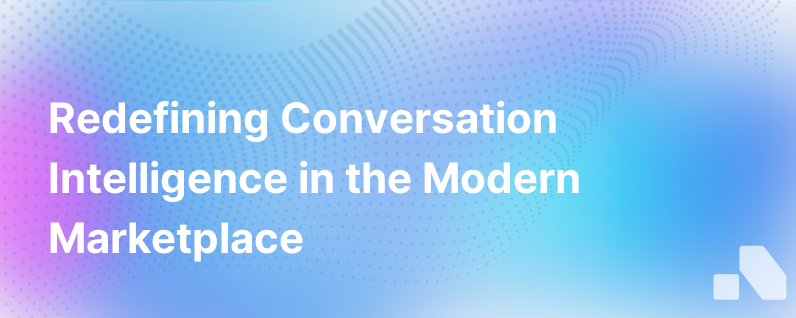
In the ever-evolving landscape of B2B sales, the mantra of "adapt or perish" has never been more appropriate. Traditional conversation intelligence, the once-revered silver bullet for sales coaching and deal insights, is facing a reckoning. In an interconnected and data-driven world, the static methods of the past are no longer adequate.
The Rise and Fall of Traditional Conversation Intelligence Traditional conversation intelligence platforms revolutionized sales by transcribing calls and offering keyword-driven insights. For years, this was a game-changer, allowing sales leaders to understand which keywords and talk tracks correlated with successful outcomes.
But the landscape of B2B sales has shifted from a solution-centric approach to one deeply anchored in customer-centricity. This subtle yet seismic change has rendered traditional conversation intelligence tools obsolete, for several reasons.
First is the sheer breadth and complexity of conversations. Gone are the days of keyword bingo—successful sales reps now navigate nuanced discussions, understanding that the depth of interaction is a key determinant of success.
Second is the dynamic nature of customer needs. Sales conversations are increasingly complex, as businesses evolve and adapt to changing market conditions. Today's sales insights need to be prescient, not historical.
Lastly, traditional models ignored a crucial element—the customer’s voice. This pivot from a one-sided analysis to a holistic view is a critical step forward for any forward-thinking sales organization.
The Pitfalls of Traditional Models
While offering benefits, traditional conversation intelligence had discernible shortcomings:
- Limited Contextual Understanding: Traditional systems analyzed keywords but often missed context, projecting oversimplified and sometimes misleading interpretations.
- Static Data Sets: Once transcribed, conversations became static datasets, unable to evolve with the changing tides of customer sentiment and market trends.
- Reactivity Over Proactivity: Insights were rooted in past interactions, leaving sales reps reacting to historical data rather than engaging prospects with anticipatory, strategic insights.
The New World of Conversation Intelligence In this new paradigm, conversation intelligence must be dynamic, deeply integrated, and contextually aware. This means moving away from retrospective analytics to predictive and prescriptive intelligence.
Sophisticated AI platforms like Aomni are pioneering this space, breathing new life into conversation intelligence. Aomni not only transcribes but also interprets nuances, sentiment, and buyer engagement, turning every interaction into a learning moment that can inform future conversations.
Predictive Analytics and Machine Learning: The New Frontier
The synergy of predictive analytics and machine learning introduces a transformative approach to conversation intelligence.
- Behavioral Analysis: Rather than mere keyword spotting, new systems analyze verbal cues, pitch, tone, and cadence to infer sentiment and engagement levels.
- Real-time Insights: Modern tools offer real-time suggestions during calls, elevating sales rep performance on the fly. No more post-mortem analyses—a sales rep can steer the conversation in the direction that Aomni’s AI predicts will be more successful.
- Prescriptive Actions: Beyond predicting outcomes, these tools prescribe the best course of action, empowering sales reps with actionable recommendations.
- Contextual Understanding: AI-driven systems contextually understand industry jargon and complex dialogue, accurately capturing the essence of each conversation.
- Data Integrations: Insights from conversations are integrated with CRMs and other sales intelligence tools, enriching the entire sales ecosystem.
- Continuous Learning: Every conversation makes the intelligence platform smarter, ensuring that insights are ever-improving and up-to-date.
The Human AI Collaboration: Enhanced Sales Conversations
The new-wave conversation intelligence works best when paired with human touchpoints. While AI interprets data and provides actionable insights, it is the human sales rep's empathy, intuition, and strategic flexibility that closes deals.
This collaboration ushers in an era where AI assistants serve as real-time advisors to sales teams. The focus shifts to how well reps can interpret and act on AI-generated intelligence, personalizing each client interaction with more relevant and timely insights.
Customer-Centricity: Measuring What Matters
Customer-centric models call for a recalibration of our metrics. Old models focused on talk-time ratios and keyword counts, but today, customer satisfaction, sentiment change, and engagement levels are the real measures of success. As we transition, it's critical to create metrics that truly reflect the new values and capabilities we bring to customer conversations.
Adaptation: The Road Ahead
As traditional conversation intelligence fades into the backdrop, it's clear that adaptation isn't just a nicety—it's a necessity for survival. Businesses that grasp the potential of new conversation intelligence tools, such as Aomni, will possess a significant edge.
Embracing this AI-driven transition will require shifts in mindset, sales training, and data management. Sales teams should be trained not only in product knowledge but also in leveraging real-time insights to enhance their conversational skills and strategy.
From sales reps to executives, each team member plays a role in this evolution, ensuring every conversation is informed by intelligence that is as dynamic and nuanced as the market itself.
In conclusion, the traditional conversation intelligence is not just dead; it's evolved. The capabilities at our disposal open up new vistas for engaging customers and holding genuinely transformational conversations. With platforms like Aomni leading the charge, the question isn't about the death of an old tool but the exciting possibilities heralded by its successor.